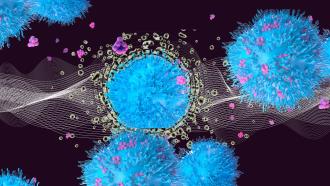Researchers at the Karnataka University here have explored the wound healing properties of silk mats made from the silk of a wild species of silkworm, Antheraea mylitta, commonly called the tasar silkworm. The study finds that tasar silk mats serve as a good scaffold in tissue engineering applications as it enables the attachment and growth of cells. The findings of the study were published in Nature’s journal Scientific Reports.
Tissue engineering is a new approach to regenerative medicine where damaged cells in various tissues are replaced with cells or tissues that have been grown in petri plates, by using cells collected from other parts of the body. Hence, unlike organ or tissue transplants, this approach reduces the risk of rejection by the body. Here, scientists mimic the manner in which cells grow and divide within the body in the lab. In order to do this, cells of the required type are collected and are cultured on materials which enable cells to attach and grow. These materials, called scaffolds, can be made from a variety of natural or synthetic polymers. In this study, the researchers have examined the ability of silk from A. mylitta to be used as scaffold.
What made the authors consider silk mats as a potential scaffold material? “Silk threads have been used for biomedical applications such as sutures, for centuries. Silk mats are now increasingly being recognized as a promising material for reconstructive surgery due its structural and morphological characteristics which facilitate ease of processing, easy attachment of cells, compatibility with our body cells, remarkable mechanical properties and the ability to degrade within our body within the required amount of time, making it ideal for biomedical applications”, says Prof. Shyamkumar Vootla, Associate Professor at the Department of Biotechnology and Microbiology, Karnatak University, Dharwad.
Previous studies have demonstrated the use of silk from the widely domesticated mulberry silkworm (Bombyx mori) as scaffolding material, but this the first time a wild variety of silk from tasar silkworm is used. “Non-mulberry silk from species like A. mylitta has not received much attention”, says Prof. Vootla. “In our lab, we are working mainly on A. mylitta, and have established and standardized extraction of wild silk proteins called sericin and fibroin from A. mylitta cocoons. We have also shown that the fibers from this silk are compatible with our tissues and had no harmful effects when coated with certain types of polymers and have demonstrated this by growing keratinocytes (skin cells) on this material. This paved a way to pursue our current research.”
In order to understand the physical, chemical and mechanical properties of silk mats made from from A. mylitta, the researchers conducted a series of tests. They found that as compared to silk mats derived from B. mori, A. mylitta silk mats were less porous, more dense and had an almost continuous sheet of sericin, the protein which makes silk conducive to being a good scaffold material. In addition, silk from A. mylitta had specific amino acids that facilitate greater cell attachment. Additionally, it was also found that A. mylitta silk had a much higher deposition of calcium oxalate crystals distributed on the surface, which made it thermally stable as compared to the silk from B. mori.
The researchers then tested the new tasar silk mats as scaffolding to grow keratinocytes -- a type of skin cells. Although the new silk mat, like mulberry silk mat, was compatible with the cells, the densities of cells on the former were significantly higher. They also cultured cells on A. mylitta silk mats without the sericin content and found that now the cell densities were much lower than the untreated mats. This confirms that the presence of a high content of sericin is one of the features that enables A. mylitta silk mats to be good scaffolds.
Although this study focused on growing skin cells on the newly designed mats, the researchers claim that it could be used as scaffold for growing a wide variety of cells. “Evidence from current research from various other labs has shown that collagen-fibroin blend and lactose-fibroin conjugates support the proliferation of hepatocytes (liver cells). Silk protein has also been demonstrated to support the growth and proliferation of Schwann cells and dorsal root ganglia (different types of cells in the nervous system) and has, therefore, been proposed as a potential scaffold for the tissue engineering of nerve grafts and our future research is oriented towards use of conductive silk polymers for nerve tissue engineering”, signs off Prof. Vootla.






